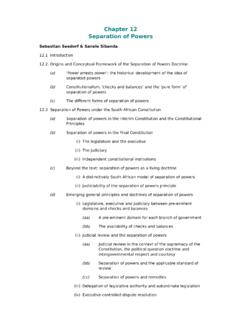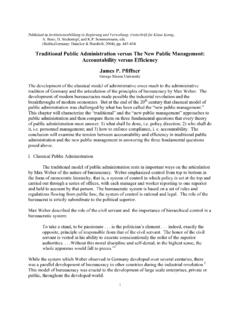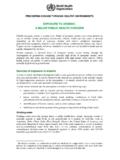Transcription of Sucrose density gradient centrifugation for efficient ...
1 NIST Special Publication 1200-24 Sucrose density gradient centrifugation for efficient separation of engineered nanoparticles from a model organism, Caenorhabditis elegans Version M. E. Johnson A. R. Montoro Bustos S. K. Hanna E. J. Petersen K. E. Murphy L. L. Yu B. C. Nelson M. R. Winchester This publication is available free of charge from: NIST Special Publication 1200-24 Sucrose density gradient centrifugation for efficient separation of engineered nanoparticles from a model organism, Caenorhabditis elegans Version M. E. Johnson A.
2 R. Montoro Bustos S. K. Hanna E. J. Petersen K. E. Murphy L. L. Yu B. C. Nelson M. R. Winchester Chemical Sciences Division Material Measurement Laboratory This publication is available free of charge from: October 2017 Department of Commerce Wilbur L. Ross, Jr., Secretary National Institute of Standards and Technology Walter Copan, NIST Director and Undersecretary of Commerce for Standards and Technology Certain commercial entities, equipment, or materials may be identified in this document in order to describe an experimental procedure or concept adequately.
3 Such identification is not intended to imply recommendation or endorsement by the National Institute of Standards and Technology, nor is it intended to imply that the entities, materials, or equipment are necessarily the best available for the purpose. National Institute of Standards and Technology Special Publication 1200-24 Natl. Inst. Stand. Technol. Spec. Publ. 1200-24, 24 pages (October 2017) CODEN: NSPUE2 This publication is available free of charge from: i This publication is available free of charge from: FOREWORD This National Institute of Standards and Technology (NIST) special publication (SP) is one in a series of NIST SPs that address research needs articulated in the National Nanotechnology Initiative (NNI) Environmental, Health, and Safety Research Strategy published in 2011.
4 [1] This Strategy document identified a Nanomaterial Measurement Infrastructure (NMI) as essential for science-based risk assessment and risk management of nanotechnology-enabled products as pertaining to human health, exposure, and the environment. Increasing production and subsequent incorporation of engineered nanomaterials (ENMs) into consumer products enhances the probability of ENM release into the environment. Thus, the necessity to understand the interactions between ENMs and environmental and biological systems persists.
5 Whole organismal metrological efforts incorporate the expert skills of many disciplines across NIST. This protocol describes a strategy for separating Caenorhabditis elegans (C. elegans) from engineered nanomaterials, a critical step for accurate quantification in uptake studies. Conventional rinsing procedures, typically comprised of water or buffer rinsing steps followed by centrifugation , have been previously tested and deemed unsuitable for this purpose, even at environmentally relevant exposure concentrations. Therefore, this protocol details the development and assessment of a unique Sucrose density gradient centrifugation procedure for the efficient separation of nanoparticles and C.
6 Elegans at the end of an exposure protocol. The example outlined in this SP pertains to the measurement of gold nanoparticles (AuNPs) and C. elegans. However, this method can potentially be implemented in bioaccumulation studies involving other organisms and with different metallonanoparticles. Visit to check for revisions and additions to this protocol or for new protocols in the series. We also encourage users to report citations to published work in which this protocol has been applied. ii This publication is available free of charge from: Table of Contents 1.
7 Introduction .. 1 2. Principles and Scope .. 1 3. Terminology .. 2 4. Reagents, Materials, and Equipment .. 2 5. Preparation of C. elegans .. 3 6. Preparation of Sucrose solutions .. 3 7. Preparation of mol L-1 NaCl .. 3 8. Preparation of nanosuspensions .. 3 9. Construction of Sucrose density gradient separation column .. 3 10. Preparation of nematode/nanosuspension mixture .. 4 11. Centrifugal separation .. 4 12. Extraction of gradient sample fractions .. 4 13. Preparation of aqua regia .. 5 14. Preparation of the internal standard diluent .. 5 15. Acid digestion of gradient sample fractions.
8 5 16. Preparation of the ionic standard solution calibrants .. 6 17. Measurement of total Au in gradient sample fractions by ICP-MS .. 6 18. Quantification of total Au in gradient sample fractions .. 6 19. 7 Visual observations .. 7 ICP-MS results and implications .. 7 20. Acknowledgements .. 17 21. References .. 17 List of Tables Table 1. density of Sucrose solutions used for the Sucrose gradient centrifugation .. 9 Table 2. Total Au, in ng, found in gradient sample fractions following centrifugation of a mixture of 30 nm and 60 nm AuNPs (NIST) at 100 ng mL-1, respectively.
9 Note that 2 mL of the mixture of AuNPs was added to the gradient , accounting for 400 ng of total Au.. 10 Table 3. Relative % Au found in gradient sample fractions following centrifugation of a mixture of 30 nm and 60 nm AuNPs (NIST) at 100 ng mL-1, respectively.. 11 Table 4. Total Au, in ng, found in gradient sample fractions following a 0 h nematode exposure to a mixture of 30 nm and 60 nm AuNPs (NIST) at 100 ng mL-1, respectively. Note that 2 mL of the mixture of nematode/AuNP suspension was added to the gradient , accounting for 200 ng of total Au.. 12 iii This publication is available free of charge from: Table 5.
10 Relative % Au found in gradient sample fractions following a 0 h nematode exposure to a mixture of 30 nm and 60 nm AuNPs (NIST) at 100 ng mL-1, respectively.. 13 List of Figures Figure 1. Representative schematics of (A) mixed-stage nematodes, (B) the nanosuspension containing 30 nm and 60 nm AuNPs at 100 ng mL-1, respectively, and (C) the nematode/nanosuspension mixture. The construction of the Sucrose density gradient column within a centrifuge tube from top to bottom: 2 mL of the nanosuspension (D) or 2 mL of the nematode/nanosuspension mixture (E), 2 mL of 100 mol/L NaCl (light green) + Sucrose [4 mL of 20 % (mass density ; purple), 3 mL of 40 % (mass density ; orange), and 2 mL of 50 % (mass density ; red)].
















